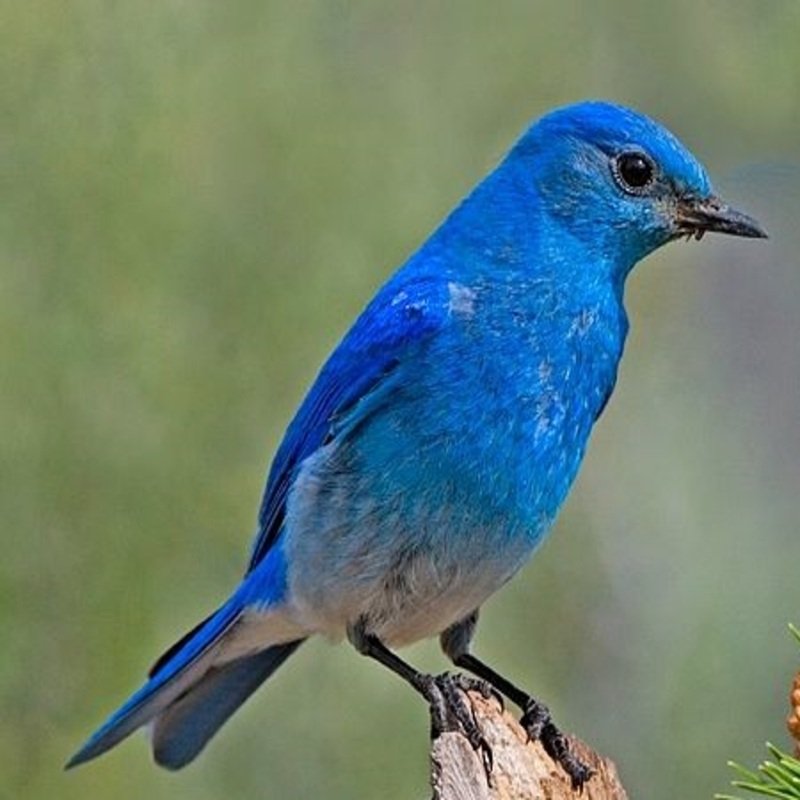The mountain bluebird, Sialia currucoides is a migratory thrush found in western North America’s mountains. With a white belly and black eyes. Males have narrow bills and are turquoise-blue above and paler below. Their song is a warbled high ‘chur chur’. The Idaho and Nevada state birds. Wild, it can survive 6–10 years as an omnivore.
Quick Overview: Sialia Currucoides – Mountain Bluebird
Body size: Around 7-7.25 in (18-18 cm) and a weight of 31 g (1.1 oz)
Main colors: Blue, Gray-brown, Ash-gray
Range: Western United States
Migratory Bird: Yes
Best time of the year to see in the U.S.: June, July, August, September
Conservation Status: Least Concern
Mountain Bluebird Description
Mountain bluebirds are nicknamed “the bluest of the bluebirds” because of their pure blue feathers. Adult males have beautiful cerulean and cobalt blue top feathers. Males’ necks and upper chests are a deep cerulean blue, diminishing to a light white at their stomachs. Female mountain bluebirds are less colorful. Their heads and backs are usually grayish-brown to ashy-gray. Their necks, chests, and upper bellies are pale grayish-brown to ashy-gray. Female mountain bluebirds have a cerulean patch on their rumps. Females resemble female eastern and western bluebirds.

Size
These birds have a length of 7-7.25 in (18-18 cm) and a weight of 31 g (1.1 oz). Their wings could range from 11-12.75 in (29-32 cm).
Feeding
Mountain bluebirds may consume seeds and fruits, but their main diet is invertebrates. Mountain bluebirds eat caterpillars, grasshoppers, crickets, cicadas, spiders, and other insects. They enjoy barren pastures to forage for ground-dwelling invertebrates (which are favored over arboreal and aerial insects).
Habitat
Mountain bluebirds may be found in a range of grassland and savannah-like settings with scattered trees and nesting places. They avoid thick woodlands and prefer wide fields with scattered trees. They are more prevalent in anthropogenically altered regions like clear-cut woods, fire-damaged areas (as long as some trees remain for nesting), and locations with large numbers of constructed nest boxes (such as southwestern Manitoba). This makes the early successional phases favorable for mountain bluebirds.
Behavior
These birds are not very sociable, with most intraspecific interactions occurring during the non-breeding season. Although little is known about their migratory activity, they are frequently encountered in flocks. Mountain bluebirds are fiercely territorial during mating season, protecting their joint areas after partnering.
Sialia Currucoides Scientific Classification
- Kingdom: Animalia
- Phylum: Chordata
- Subphylum: Chelicerata
- Class: Aves
- Order: Passeriformes
- Family: Turbidae
- Genus: Sialia
- Species: Sialia currucoides
Best time of the year to see
The best time to see these birds in the United States is during the summer season (June – September).
Distribution of the Mountain Bluebird in the USA
Breeds in southern Alaska and the Yukon, as well as in eastern Manitoba and western Nebraska, New Mexico, Arizona, and southern California. Winters in Oregon and Colorado then travels south across Hawaii, Idaho, Montana, Nevada, Utah, Washington, and Wyoming in the western United States.
